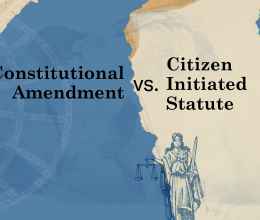The Ohio Supreme Court recently issued a new report documenting the use of mayor’s courts in 2013 and highlighting a decade-long decline in caseloads. But don’t let that fact fool you.
Sure, mayor’s courts in Ohio are hearing 14 percent fewer cases than 10 years ago, but other kinds of courts are hearing fewer cases, too. The real story is that mayor’s courts are alive and well and still hear an outrageous number of cases when compared to the town’s population.
The statewide average is 18.6 cases for every 100 residents, but many mayor’s courts far exceed that number. For example, Hanging Rock issued 1,060 tickets per 100 residents, Linndale issued 629, and Arlington Heights issued 332.
Many of the towns with mayor’s courts are accused of being “speed traps” that issue large numbers of traffic citations. And it’s true, the number of traffic cases actually rose 3 percent last year even though the overall number of cases is declining.
What are mayor's courts? Mayor's courts are local courts established by municipalities that have more than 200 residents and no municipal court. These courts may hear misdemeanor violations of local ordinances; however, over 83 percent of cases are traffic related.
Most individuals who receive a citation don’t fight it. Nearly 80 percent either chose to pay the citation without attending court or pled guilty or no contest in court. The number of individuals who opted to go to trial is negligible.
The decline in mayor’s courts’ caseloads does not solve their many problems:
1. Education & Qualifications
Last year mayors presided over 330 trials, and magistrates oversaw 1,586. That’s right, mayors can choose to oversee mayor’s court themselves…even if they do not have a law degree or any litigation or judicial experience. Alternatively, mayors can appoint attorneys with as a little as three years’ experience to be a mayor’s court magistrate.
2. Conflict of Interest
“The judge is sitting there running a court in which his or her principal objective is what’s in the cash register at the end of the evening.”
Justice Paul E. Pfeifer (Columbus Dispatch, July 22, 2012)
Revenue collected from fines and court costs issued by mayor's courts goes directly to the town’s coffers. During times of economic stress, the mayor or magistrate may not be able to look past the fact that more guilty pleas equals more money for the town. Does that sound like an impartial hearing to you?
3. Oversight and Accountability
Mayor’s courts are largely unregulated. Since mayor’s courts are a product of the legislature, the Ohio Supreme Court has little authority over them. This is especially worrisome, as the ACLU of Ohio’s April 2013 report The Outskirts of Hope noted that many mayor’s courts engage in debtors’ prison, violating the law by incarcerating individuals for failure to pay fines.
For years, the late Supreme Court Chief Justice Thomas H. Moyer advocated to abolish mayor’s courts in Ohio. Slowly, we are making progress towards that goal. Recent legislation shrank the number of mayor’s courts from 333 in 2010 to 310 in 2013. But that simply isn’t enough.
Only two states still have mayor’s courts—Ohio and Louisiana—sure sign that mayor’s courts are an outdated system that compromises the integrity of our judicial system. Ohio doesn’t need fewer mayor’s courts or fewer cases heard in mayor’s courts. We need to abolish mayor’s courts once and for all.







